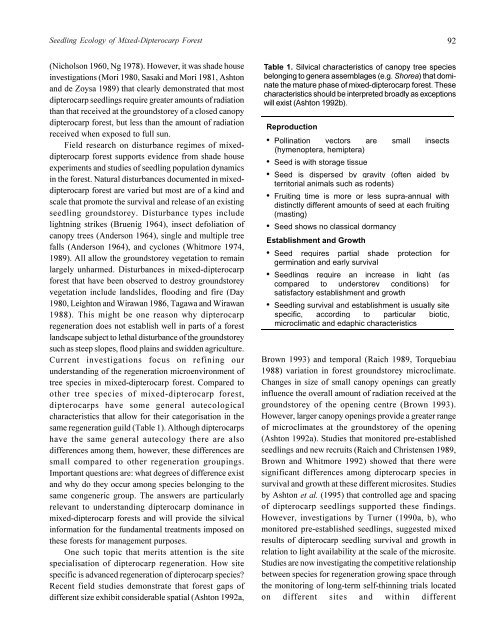A review of dipterocarps - Center for International Forestry Research
A review of dipterocarps - Center for International Forestry Research
A review of dipterocarps - Center for International Forestry Research
You also want an ePaper? Increase the reach of your titles
YUMPU automatically turns print PDFs into web optimized ePapers that Google loves.
Seedling Ecology <strong>of</strong> Mixed-Dipterocarp Forest<br />
(Nicholson 1960, Ng 1978). However, it was shade house<br />
investigations (Mori 1980, Sasaki and Mori 1981, Ashton<br />
and de Zoysa 1989) that clearly demonstrated that most<br />
dipterocarp seedlings require greater amounts <strong>of</strong> radiation<br />
than that received at the groundstorey <strong>of</strong> a closed canopy<br />
dipterocarp <strong>for</strong>est, but less than the amount <strong>of</strong> radiation<br />
received when exposed to full sun.<br />
Field research on disturbance regimes <strong>of</strong> mixeddipterocarp<br />
<strong>for</strong>est supports evidence from shade house<br />
experiments and studies <strong>of</strong> seedling population dynamics<br />
in the <strong>for</strong>est. Natural disturbances documented in mixeddipterocarp<br />
<strong>for</strong>est are varied but most are <strong>of</strong> a kind and<br />
scale that promote the survival and release <strong>of</strong> an existing<br />
seedling groundstorey. Disturbance types include<br />
lightning strikes (Bruenig 1964), insect defoliation <strong>of</strong><br />
canopy trees (Anderson 1964), single and multiple tree<br />
falls (Anderson 1964), and cyclones (Whitmore 1974,<br />
1989). All allow the groundstorey vegetation to remain<br />
largely unharmed. Disturbances in mixed-dipterocarp<br />
<strong>for</strong>est that have been observed to destroy groundstorey<br />
vegetation include landslides, flooding and fire (Day<br />
1980, Leighton and Wirawan 1986, Tagawa and Wirawan<br />
1988). This might be one reason why dipterocarp<br />
regeneration does not establish well in parts <strong>of</strong> a <strong>for</strong>est<br />
landscape subject to lethal disturbance <strong>of</strong> the groundstorey<br />
such as steep slopes, flood plains and swidden agriculture.<br />
Current investigations focus on refining our<br />
understanding <strong>of</strong> the regeneration microenvironment <strong>of</strong><br />
tree species in mixed-dipterocarp <strong>for</strong>est. Compared to<br />
other tree species <strong>of</strong> mixed-dipterocarp <strong>for</strong>est,<br />
<strong>dipterocarps</strong> have some general autecological<br />
characteristics that allow <strong>for</strong> their categorisation in the<br />
same regeneration guild (Table 1). Although <strong>dipterocarps</strong><br />
have the same general autecology there are also<br />
differences among them, however, these differences are<br />
small compared to other regeneration groupings.<br />
Important questions are: what degrees <strong>of</strong> difference exist<br />
and why do they occur among species belonging to the<br />
same congeneric group. The answers are particularly<br />
relevant to understanding dipterocarp dominance in<br />
mixed-dipterocarp <strong>for</strong>ests and will provide the silvical<br />
in<strong>for</strong>mation <strong>for</strong> the fundamental treatments imposed on<br />
these <strong>for</strong>ests <strong>for</strong> management purposes.<br />
One such topic that merits attention is the site<br />
specialisation <strong>of</strong> dipterocarp regeneration. How site<br />
specific is advanced regeneration <strong>of</strong> dipterocarp species?<br />
Recent field studies demonstrate that <strong>for</strong>est gaps <strong>of</strong><br />
different size exhibit considerable spatial (Ashton 1992a,<br />
92<br />
Table 1. Silvical characteristics <strong>of</strong> canopy tree species<br />
belonging to genera assemblages (e.g. Shorea) that dominate<br />
the mature phase <strong>of</strong> mixed-dipterocarp <strong>for</strong>est. These<br />
characteristics should be interpreted broadly as exceptions<br />
will exist (Ashton 1992b).<br />
Reproduction<br />
• Pollination vectors are small insects<br />
(hymenoptera, hemiptera)<br />
• Seed is with storage tissue<br />
• Seed is dispersed by gravity (<strong>of</strong>ten aided by<br />
territorial animals such as rodents)<br />
• Fruiting time is more or less supra-annual with<br />
distinctly different amounts <strong>of</strong> seed at each fruiting<br />
(masting)<br />
• Seed shows no classical dormancy<br />
Establishment and Growth<br />
• Seed requires partial shade protection <strong>for</strong><br />
germination and early survival<br />
• Seedlings require an increase in light (as<br />
compared to understorey conditions) <strong>for</strong><br />
satisfactory establishment and growth<br />
• Seedling survival and establishment is usually site<br />
specific, according to particular biotic,<br />
microclimatic and edaphic characteristics<br />
Brown 1993) and temporal (Raich 1989, Torquebiau<br />
1988) variation in <strong>for</strong>est groundstorey microclimate.<br />
Changes in size <strong>of</strong> small canopy openings can greatly<br />
influence the overall amount <strong>of</strong> radiation received at the<br />
groundstorey <strong>of</strong> the opening centre (Brown 1993).<br />
However, larger canopy openings provide a greater range<br />
<strong>of</strong> microclimates at the groundstorey <strong>of</strong> the opening<br />
(Ashton 1992a). Studies that monitored pre-established<br />
seedlings and new recruits (Raich and Christensen 1989,<br />
Brown and Whitmore 1992) showed that there were<br />
significant differences among dipterocarp species in<br />
survival and growth at these different microsites. Studies<br />
by Ashton et al. (1995) that controlled age and spacing<br />
<strong>of</strong> dipterocarp seedlings supported these findings.<br />
However, investigations by Turner (1990a, b), who<br />
monitored pre-established seedlings, suggested mixed<br />
results <strong>of</strong> dipterocarp seedling survival and growth in<br />
relation to light availability at the scale <strong>of</strong> the microsite.<br />
Studies are now investigating the competitive relationship<br />
between species <strong>for</strong> regeneration growing space through<br />
the monitoring <strong>of</strong> long-term self-thinning trials located<br />
on different sites and within different

















